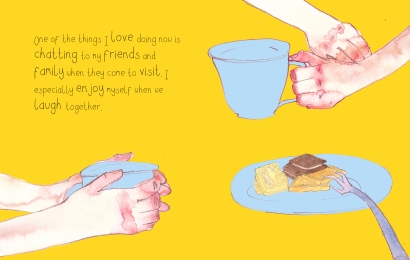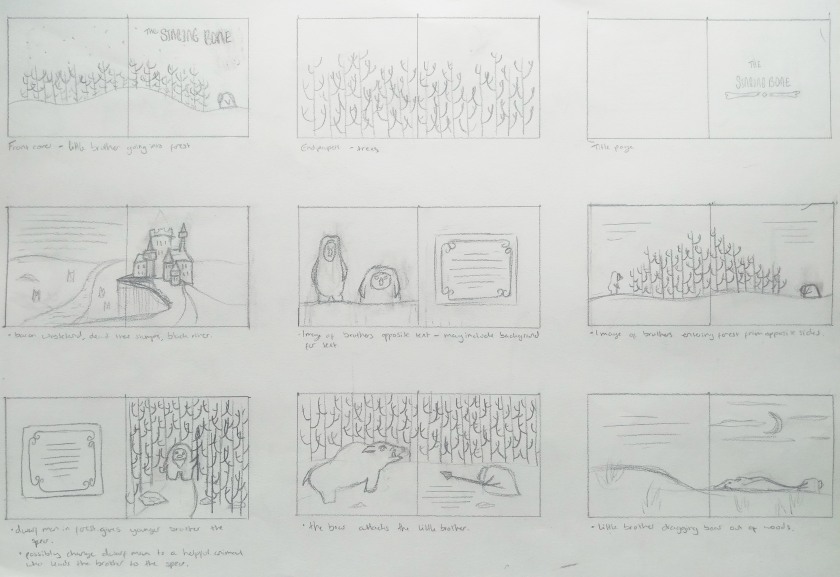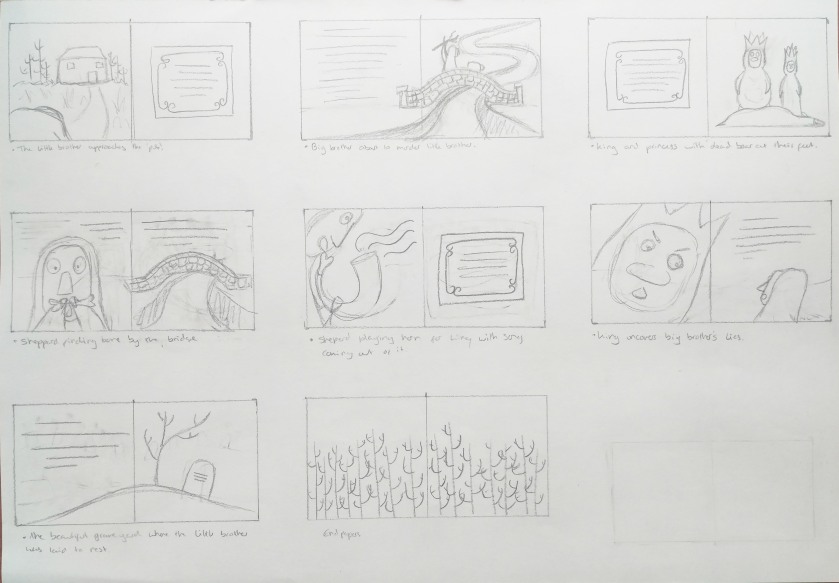After making improvements to the pages I finished my book and sent it off for print.
I am pleased with how the book turned out, the print is of a good quality and all the illustrations look how they are supposed to. I think the uncoated paper works really well with the bold, bright colours.
I think that the book communicates what it was intended to in a clear and simple way. I think that it is effective at showing people the other symptoms of dementia and that people with dementia are still themselves, they are not defined by their diagnosis. I think the bright colours and simplicity of the book make it appeal to children however I think it is a book that a parent would need to read with a child rather than a child read it alone. I think that the text communicates effectively and encourages people to empathise with those that have dementia, allowing them to understand how they can feel. I think that the illustrations along with the text allow the reader to get to know Enid, demonstrating that people with dementia are still people, they have thoughts and feelings and they have accomplished things. These are things that I feel are often forgotten when someone is diagnosed with dementia.
To improve my book I could add some more suggestions and tips on how to cope with some of the symptoms listed in the story. I think this would help people and give them some hope that dementia doesn’t have to be so negative. I could also explain how dementia causes some of these symptoms to help people better understand the disease and what is happening to their friend or relative. I think that this could be important information to include as this is something else that people don’t really know about dementia. I think I could also improve the book by including more about Enid, the main character. I think that by including more about Enid and her life it would help to really make the reader realise what people with dementia go through and how it makes them feel.
The book flows well and I think the composition is varied enough so that it doesn’t repeat itself. I found it quite difficult to illustrate the text at times as its a sensitive topic but the book also needed to be engaging. I think the use of the goblin really helped me to do this, if I had not used the metaphor at all I think the book wouldn’t appeal to children as much, but I also think that by including humour, through the goblin, it makes this serious book seem more approachable.

 Some of these tips were taken out of my research, for example, on the page about sundowning the character says she enjoys playing games to distract her. This tip was taken off the Alzheimers Society’s website where they have plenty of ideas to help people who are living with dementia. Other tips were taken directly from my experiences with my Grandmother, for example its repeated on a few pages in the book that the character likes talking about things she used to enjoy or talking with her family about her memories, this is something my Grandmother likes doing.
Some of these tips were taken out of my research, for example, on the page about sundowning the character says she enjoys playing games to distract her. This tip was taken off the Alzheimers Society’s website where they have plenty of ideas to help people who are living with dementia. Other tips were taken directly from my experiences with my Grandmother, for example its repeated on a few pages in the book that the character likes talking about things she used to enjoy or talking with her family about her memories, this is something my Grandmother likes doing. This is where the idea of the dementia goblin came from. I wanted to show that it is the dementia doing these things and not the person so I decided to use the goblin to personify dementia. I originally decided to use this metaphor on every page but it made my page layouts repetitive. I then decided that I wanted my work to focus more on the person rather than the dementia so the goblin was nearly removed from my work entirely. I ended up using the goblin on some pages as I thought the metaphor works really well when talking about some symptoms of the disease, such as sundowning where the goblin is the only character on the page.
This is where the idea of the dementia goblin came from. I wanted to show that it is the dementia doing these things and not the person so I decided to use the goblin to personify dementia. I originally decided to use this metaphor on every page but it made my page layouts repetitive. I then decided that I wanted my work to focus more on the person rather than the dementia so the goblin was nearly removed from my work entirely. I ended up using the goblin on some pages as I thought the metaphor works really well when talking about some symptoms of the disease, such as sundowning where the goblin is the only character on the page.  On other pages the goblin is less obvious, I think this works well as a gentle reminder that if someone has dementia it is always there even if it doesn’t seem like its affecting them.
On other pages the goblin is less obvious, I think this works well as a gentle reminder that if someone has dementia it is always there even if it doesn’t seem like its affecting them.






























 I was quite happy with how well the layout flowed so I will not be re-dooing this page plan but I will be doing a colour version of this to show how the book would look in colour as a whole as colour is quite important for a children’s book. I am not too happy with some of the pages but I would like to test them in colour first to see what they’d look like. I like the continuation of trees throughout my book, for example their inclusion on the endpapers, I think that it helps to bring the whole book together and that it also helps to make it flow visually. To improve it I think that the characters need to be brought to life more, on some of the pages in the book they look too wooden and not alive.
I was quite happy with how well the layout flowed so I will not be re-dooing this page plan but I will be doing a colour version of this to show how the book would look in colour as a whole as colour is quite important for a children’s book. I am not too happy with some of the pages but I would like to test them in colour first to see what they’d look like. I like the continuation of trees throughout my book, for example their inclusion on the endpapers, I think that it helps to bring the whole book together and that it also helps to make it flow visually. To improve it I think that the characters need to be brought to life more, on some of the pages in the book they look too wooden and not alive.